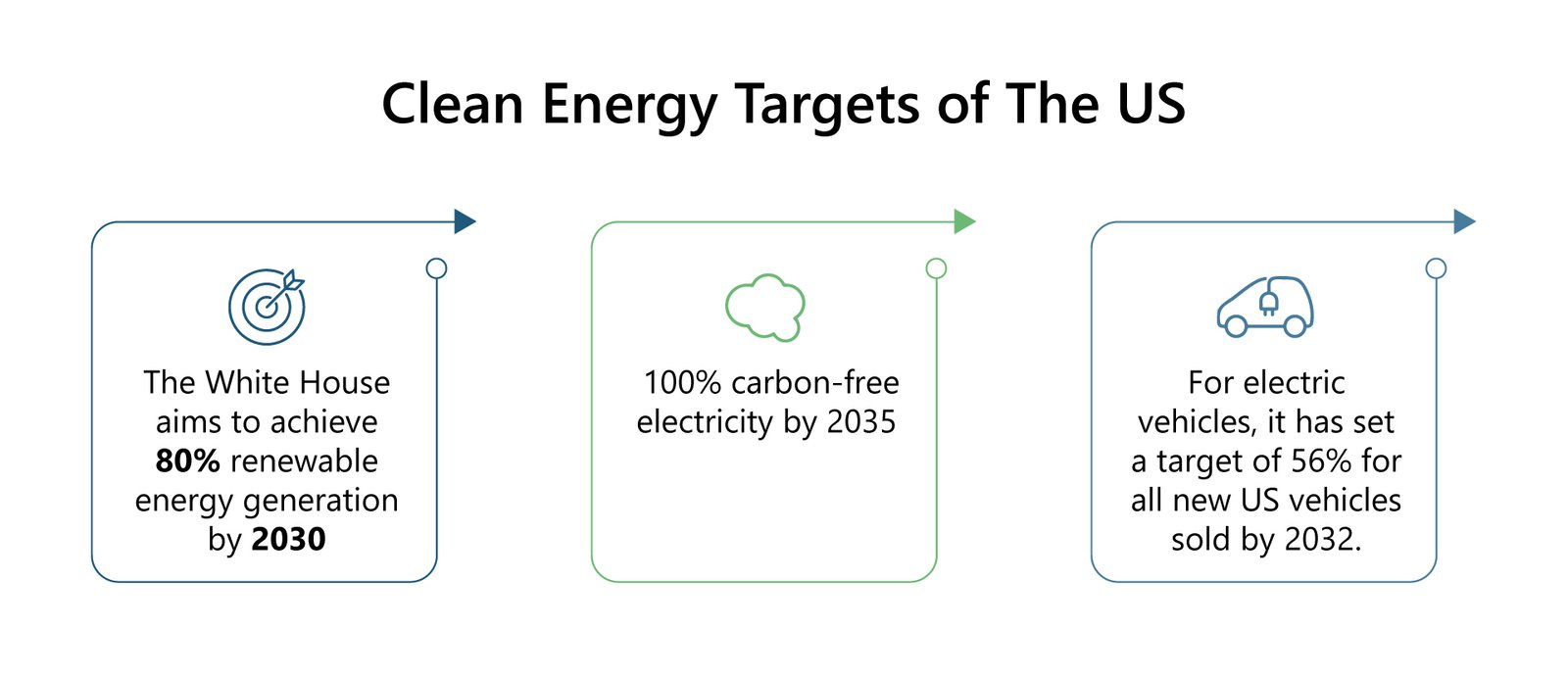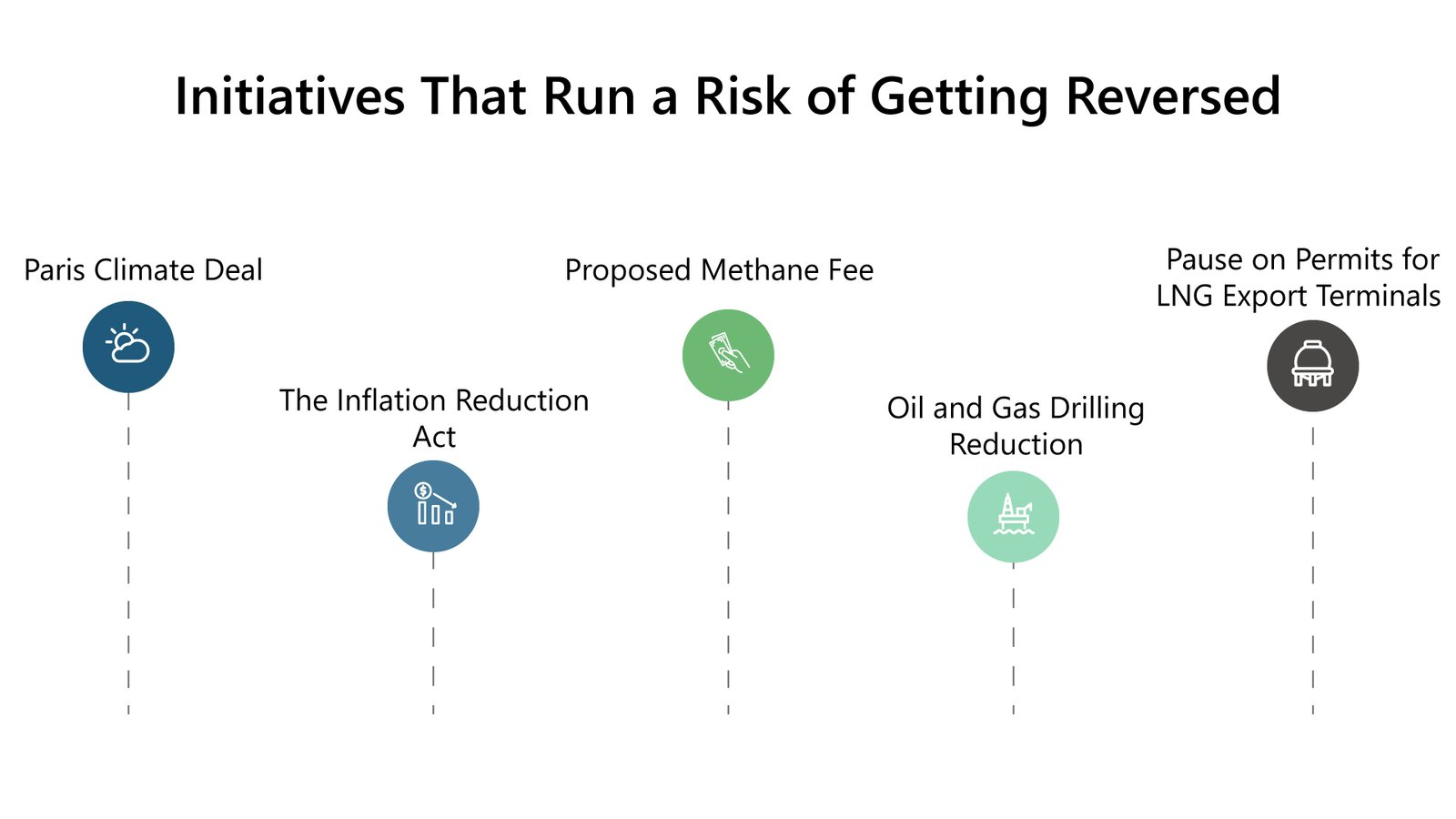- The US is making strides to move away from fossil fuels and eventually decarbonize the energy sector.
- The White House aims to achieve 80% renewable energy generation by 2030 and 100% carbon-free electricity by 2035. On the other hand, for electric vehicles, it has set a target of 56% for all new US vehicles sold by 2032
- However, the impact of elections will not be limited to clean energy initiatives but will extend to the power grid equipment market.
Under the Biden Administration, the US is making strides to move away from fossil fuels and eventually decarbonize the energy sector. The present administration has set aggressive targets for deploying renewable generation capacity and electrification of the transport sector, which releases tremendous amounts of carbon emissions.
The White House aims to achieve 80% renewable energy generation by 2030 and 100% carbon-free electricity by 2035. On the other hand, for electric vehicles, it has set a target of 56% for all new US vehicles sold by 2032.

Figure 1: Clean energy targets of the US.
Source: PTR Inc.
However, the US is heading towards an election in November, and the Democrats could lose the White House to Trump. This possibility has placed a range of key initiatives undertaken by the Biden Administration to create an enabling environment for the transition to clean energy at high risk. It is noteworthy that the impact of the elections will surely extend from clean energy initiatives to the power grid equipment market that PTR covers.

Figure 2: Initiatives that run a risk of getting reversed.
Source: PTR Inc.
Clean Energy Initiatives that Run a Risk of Getting Reversed
Major initiatives that risk getting reversed or halted include rejoining the Paris Climate Deal, the Inflation Reduction Act, the proposed methane fee, oil and gas drilling reduction, and a pause on permits for LNG export terminals.
Paris Climate Deal
The Paris Agreement is a legally binding international treaty that was adopted by 196 parties at the UN Climate Change Conference (COP21) in 2015. The treaty aims to curtail the increase in the global average temperature to well below 2 degrees Celsius above pre-industrial levels while pursuing efforts to limit the temperature increase to 1.5 degrees Celsius compared to pre-industrial levels.
The US withdrew from the Paris Agreement under the first Trump Presidency, but once Biden took office, the US rejoined. However, there is a possibility that if Trump becomes President again, the US will again pull out of the Paris Agreement.
The Inflation Reduction Act
Through the Inflation Reduction Act, the Biden Administration unlocked billions of dollars in subsidies that aimed to facilitate the adoption of renewable energy, electric vehicles, battery energy storage, heat pumps, etc.
Trump’s advisors and associates clearly indicated that they would move to scrap the IRA as well. However, scrapping the IRA will be tricky as the majority of subsidies under the IRA are reaped by the Republican states.
Proposed methane fee and oil and gas drilling reduction
The US Environmental Protection Agency has proposed a waste emission charge for methane for oil and gas facilities that produce emissions of over 25,000 metric tons of carbon dioxide equivalent. For methane emissions reported in 2024, the WEC is USD 900 per metric ton. WEC is expected to increase to USD 1200 per metric ton for emissions reported in 2025 and to USD 1500 per metric ton for emissions reported in 2026 and beyond.
It is anticipated that the Trump Administration will move to scrap the proposed methane fee for the oil and gas sector. Additionally, it will push to expand the US Interior Department’s five-year offshore oil and gas leasing program.
Pause on permits for LNG export terminals
The Biden Administration paused permits for LNG export terminals in order to ascertain the impact of LNG exports on energy costs, energy security, and the environment. When this article was being written, nearly 17 projects were awaiting approval from the Department of Energy to proceed. Though, recently, a federal district court judge has lifted pause on permits for LNG export terminals, it didn’t order the Department of Energy to approve or set a deadline for pending applications.
In a bid to usher in a new era of the fossil fuel industry, the Trump Administration is likely to expedite the process that grants permit for LNG export terminals. Notably, the US is the biggest exporter of LNG, with the exports growing exponentially since the first cargo shipped from Louisiana in 2016.
Looking Ahead
The US is headed toward Presidential elections at the end of 2024, and there is a possibility that Trump may become President for the second term. If Trump and Republicans, who have been historically pro-fossil fuel, win the election, then the fossil fuel industry in the US is expected to thrive, but at the cost of clean energy initiatives taken by the Biden Administration.
The clean energy initiatives that will suffer the most include the Paris Climate Deal, the Inflation Reduction Act, the proposed methane fee, the reduction in oil and gas drilling, and a pause on permits for LNG export terminals. Notably, rolling back the IRA may become a tricky exercise for the Trump Administration as the subsidies benefit mostly the Republican states in the US.
However, the impact of elections will not be limited to clean energy initiatives but will extend to the power grid equipment market. These clean energy initiatives have created an enabling environment for the deployment of renewable energy and electrification of the transport sector. In order to facilitate the integration of renewable energy and increased demand due to the electrification of the transport sector, the utilities are expanding and upgrading the country’s grid infrastructure. This has been driving the demand for power transformers, distribution transformers, switchgear (specifically MV switchgear), and HVDC transmission systems, which is expected to suffer in case Trump makes it to the White House.
Europe: +49-89-12250950
Americas: +1 408-604-0522
Japan: +81-80-7808-1378
GCC/Rest of APAC: +971-58-1602441
Recent Insights
COP28: Climate Concerns to Address in 2023
From flash flooding to heat waves, each progressing year is a reminder that climate change is no longer a threat that looms on the horizon, but rather a reality that countries are- often disproportionately- dealing with. Climate change flurrying out of control only...
COP28’s Global Stocktake: A Pivotal Undertaking?
The global stocktake, a quinquennial undertaking, functions as a meticulous inventory of worldwide initiatives in climate action and support, with its inaugural culmination slated for COP28 in a bid to influence the ensuing round of nationally determined contributions...
COP28: Balancing Hope and Skepticism in Climate Talks
The Conference of the Parties (COP) is the primary decision-making body of the United Nations Framework Convention on Climate Change (UNFCCC). This annual gathering of member states focuses on addressing global climate change. In the lead up to COP28, amid the rising...
TenneT’s 2 GW Program to Energize Dutch-German North Sea
• Europe is pushing to become the world’s very first climate-neutral continent by 2050, which is in line with the international commitments made by them.• Under the 2 GW Program, TenneT will build at least 14 HVDC offshore grid connection systems with a transmission...
Carbon Capture, Storage and Utilization: Transforming Emissions into Solutions
• CCUS technologies involve capturing CO2 emissions from industrial processes, utilizing it in various ways, and storing it permanently underground.• CCUS provides a cost-effective way to reduce GHG emissions from industrial processes, thereby contributing to the...
Middle East Energy (MEE) Conference Impressions 2023
The Middle East Energy (MEE) conference & trade fair in Dubai, which took place from 7th to 9th March, was a prime meeting place for professionals from all over the energy and power grid industry. The conference provided a platform for key equipment manufacturers...
North American HVDC Market (2017-2021)
The HVDC market has gained a lot traction due to the expansion of renewable energy resources across the globe. In the last decade, a significant growth in onshore renewables has been witnessed in North America. To evacuate this energy from generation centres, HVDC has...







